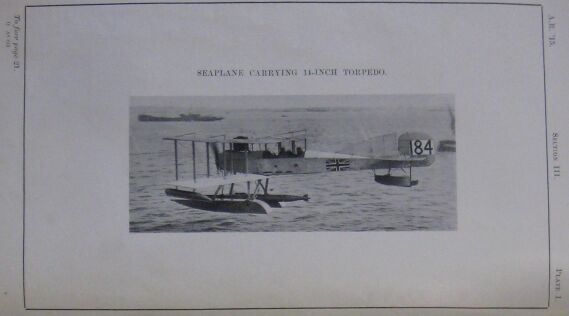Torpedo Planes
Torpedo Planes (land-based aeroplanes, floatplanes or seaplanes) were envisioned before the Great War and played an ancillary part in the war itself as small numbers of increasingly capable platforms were fielded and employed. The damage they inflicted in the war was slight, but it presaged the impact this weapon system would carry into World War II.
This article is just a stub, to start, and is primarily based upon an extract of a work entitled History of Development of Torpedo Aircraft which appeared in in the Annual Report of the Torpedo School for 1918.[1]
Early Experiments
The British felt that the first tests were made by Italian Captain Guidoni in 1911, when he released a 352-lb. torpedo from an 80 HP "Farman" aeroplane. In America, in 1912 Admiral Fiske advocated using seaplanes to carry torpedoes.
In 1913, the torpedo training school H.M.S. Vernon began experiments in conjuction with the Royal Naval Air Service employing a seaplane with sawn-down wings to operate as a hydroplane which could perform high speed drop tests as it skimmed along the surface. Later in the year a 200 HP Sopwith Canton-Unne seaplane carried a 14-in torpedo aloft at Calshot, and in September a torpedo seaplane was specially ordered for the purpose.
In mid 1914, a 160 HP Short-Gnome seaplane was experimenting with a 14-in torpedo, and finally a 225 HP Short seaplane carried one weighing 810 lbs. Felixstowe was home to much of the early experimentation.
Mid-1915 marked the Royal Navy's move to 18-in torpedoes for aerial work, as they had ordered two 310 HP Short seaplanes able to lift a 14-in Mark IX torpedo which had been especially developed for the purpose. This weapon weighed 1,000 pounds including its 170 pound T.N.T. warhead.
Development of the Arm
The 1919 Progamme provided for creation of seven Torpedo Aeroplane Squadrons, each of eighteen Sopwith T.1s capable of operating from land of from Eagle or Argus, the latter of which was completed in April 1918.
Initial pilot training was at Vernon, but this soon moved to East Fortune. The Royal Navy struggled to deliver enough torpedo officers to support the air arm, and eventually the R.A.F. had to train its own men.
Pilots practiced drops against T.B.Ds., their first three or four drops using dummy torpedoes while flying near a drifter whose mast helped them judge a good drop height. It was eventually decided that a track angle of 90° was best. Short range drops were the goal, and when concerted attack was possible, a combined first attack was to be followed by other planes saving their weapons to see if the enemy evaded with a turn. Final training would entail concerted attack on a destroyer lent from the Grand Fleet using real torpedoes set to run under the target. Photographs of the training drops were used to help record the altitude of the drops.
Attacks in the War
The first operational chance to use the weapon was lost in May 1915 during the a German coastal raid (which raid is being referred to here, I have no idea), as the plane was loaded with a bomb instead of its customary torpedo. Success would soon follow in Turkish theatre.
On 12 August 1915, a seaplane flown by Flight Commander C. H. Edmonds was launched from Ben-my-Chree to attack a ship that had been sighted in the Sea of Marmora the day before. Edmonds climbed to 800 feet and crossed the Isthmus of Bulair in the face of desultory rifle fire to discover the 2,000 ton steamer off Injeh Bornu. A successful drop was made at 350 yards, striking her amidships, but later review indicated that the ship may have already been abandoned after beaching herself after an earlier attack by the submarine E 14
On 17 August, Ben My Chree launched a second raid of two seaplanes to target transports which were resupplying Al Bashi Liman on Gallipoli. Edmonds flew one plane, and Flight Commander G. B. Dacre the other. The isthmus was crossed at 1,000 feet, and the enemy aerodrome at Galata was overflown with the cover of the vanishing night. Flying down the Strait toward the target from the direction of Galata would make the planes seem perhaps German, and put the sun behind them as they struck. Edmonds found three overlapping steamships and dropped his torpedo, hitting the middle vessel. Dacre's machine suffered from poor engine performance which required him to set it down on the Straits before reaching Al Bashi Liman. He spotted a steam tug on the Asiatic shore and puttered over to her, taxiing in to drop his torpedo in the face of rifle fire. Thus unburdened, Dacre was able to coax his machine back into the air for a nape-of-the-earth flight back to his ship.
Unfortunately, it was deemed that these attacks demonstrated that the climatic conditions off Gallipoli were such that newer machines were required to safely carry out torpedo attacks, and so further efforts were set aside.
See Also
Footnotes
- ↑ Annual Report of the Torpedo School, 1918. pp. 89-96.
